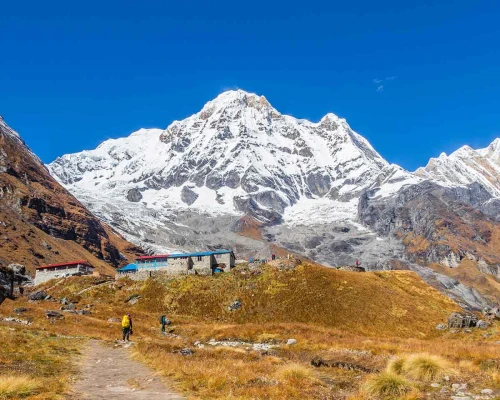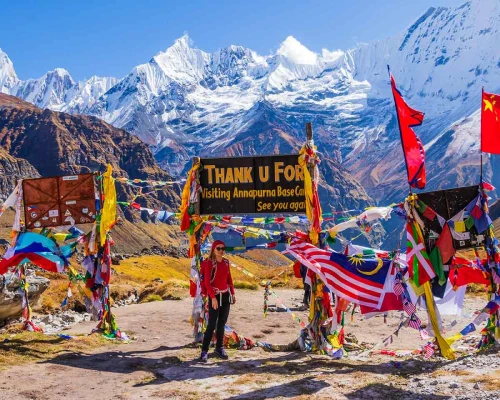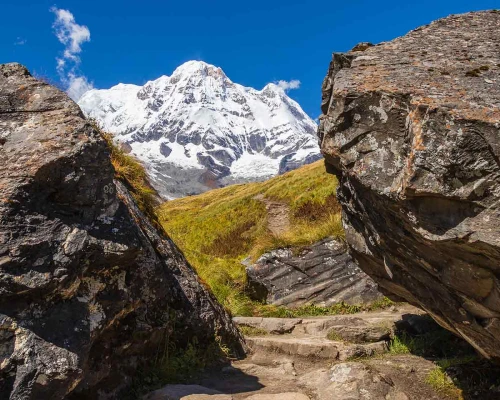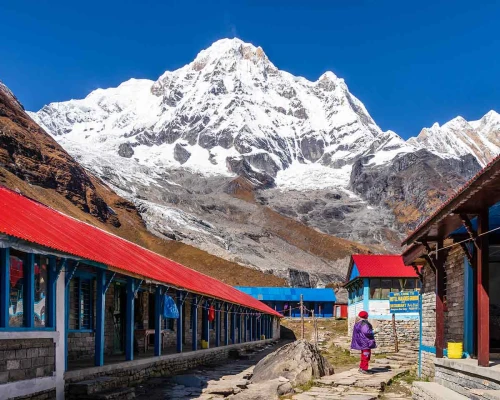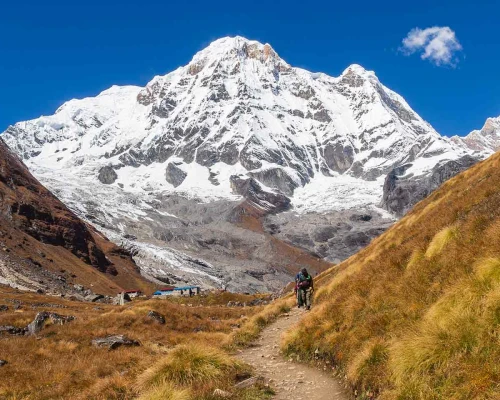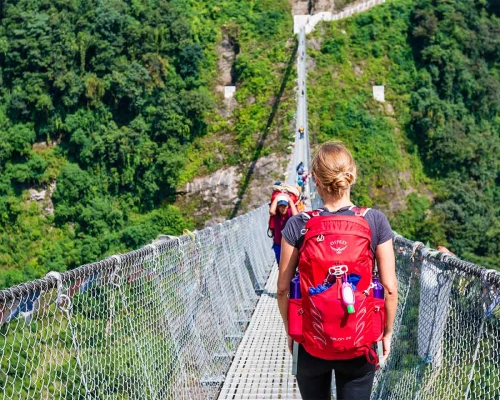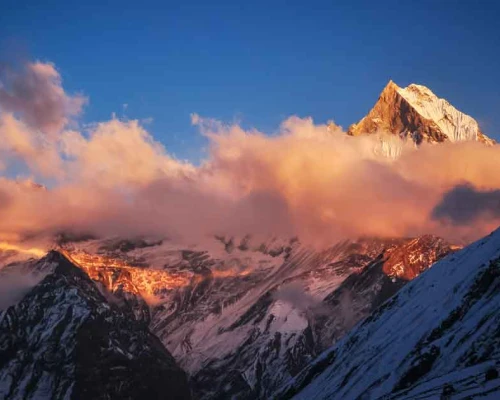Annapurna base camp short trek is one of the most convenient and easy treks, which gives you an opportunity to explore the Annapurna region within just 5 days. The short Annapurna base camp trek is a 5 day adventure through some of the most spectacular terrain in Nepal. The trails of this trek pass through glaciers, rhododendrons, oak woods, and waterfalls.
Additionally, you'll get to see some of the rarest wildlife on the planet, such as red pandas and snow leopards. The trek is rewarding, as you will reach Annapurna base camp and get to see the Himalayas clearly. Our short 5 day trek to Annapurna base camp package is perfect if you are looking for a gateway to the Himalayas without having to compromise too much of your time.
This short ABC trek is full of wildlife, towns, and cultures. You will get a breathtaking view of the Annapurna South (7,219m), Annapurna I (8,091m), Mardi Himal (5553m), Mt. Machhapuchhre (fishtail) (6,997m), Gangapurna (7,455m), and a few more mountains.
The five-day ABC trek primarily travels through verdant forests. Your route will follow the Modi River, which originates in the Annapurna Glaciers and flows from Annapurna I, an 8091-meter mountain, from Deaurali to Annapurna base camp via Machhapuchre base camp.
A 5-day short trek to Annapurna base camp offers an excellent route that includes Pokhara, Nayapul, Ghandruk, Chhomrong, Sinuwa, Bamboo, Dovan, Himalaya, Deurali, MBC (Machhapuchhre base camp), ABC (Annapurna base camp), and Siwai. You will experience different cultures, traditions, and beautiful natural scenery along the way.
So why wait? We go above and beyond at NTA to support you in achieving all of your trekking goals, ensuring a safe and comfortable journey. We are excited to travel with you to have treasured experiences throughout the ABC short trek. The bookings are open for the years 2025, and 2026, so please contact us and make your bookings now.
Annapurna Base Camp Short Trek Route
Your short trek to Annapurna base camp starts in Pokhara. If you want to do this trek from Kathmandu, please see our Add-Ons option.
On the day of your trek, our team members will be there at your hotel to pick you up in our private tourist transportation. From Pokhara, we will head towards Jhinu, which is about a three-hour drive from Pokhara.
After reaching Jhinu, we will officially start trekking as we head towards Sinuwa for our overnight stay. The next day, from Sinuwa, we will either stay at Himalaya or trek for 1 and a half to 2 hours towards Deurali. This depends on your pace and the route you are willing to take.
On the third day, the route will follow either the Himalaya or Deurali, depending on where you stay, towards Annapurna base camp. Before reaching Annapurna base camp, your trail will also take you to Macchapuchre base camp. From Machhapuchre base camp to ABC, it is only about 2 hours.
After spending an overnight in Annapurna base camp, you will descend towards Sinuwa, retracing your route back to Pokhara.
Why should you do the Annapurna Base Camp Short Trek?
This five-day trek is perfect for anyone with limited time or intermediate fitness levels since it simplifies the traditional ABC trek into a more manageable schedule.
You will still be able to see the magnificent views of the Annapurna range, which includes the well-known Machhapuchhre (Fishtail Peak). This trek passes through a range of environments, including high-altitude meadows, canyons, and lush bamboo forests with rushing waterfalls.
You will also come across quaint villages where the Gurung and Magar communities live, providing an insight into their customs.
This five-day ABC trek is a well-traveled path with many teahouses and hotels along the way, making planning and traveling comparatively simple. You have the option of doing a private trek or on a group-sharing basis.
Altitude sickness is less likely due to the 5-day trek's steady rise, which improves acclimation to the high altitude. For those who are not adapted to trekking at high elevations, this is quite crucial.
Benefits of booking Annapurna Base Camp Short Trek with us
Here are some of the reasons why you should book your short trek to ABC with NTA.
- Simple reservation and booking process
- We offer free cancellation service if informed 90 days prior the trek
- Upon booking confirmation, a brief travel briefing will be held after your arrival
- Simple payment method
- 24/7 communication by contacting: +977 98515 88 555 (Binod Sapkota)
- Highly expert and experienced team
- Customization provided for your 5-day trek to Annapurna base camp according to your request
- Commitment to responsible and sustainable tourism
Best Season for Annapurna Base Camp Short Trek
The best seasons to do an ABC short trek are the spring season (March to May) and the autumn season (September to November).
Spring Season
The spring runs from March to May. With good reason, spring is frequently regarded as the ideal season for this trek. In the springtime, the Annapurna area has its most pleasant weather. You can take in the breathtaking scenery without enduring the misery of the bitter cold because the days are mild. Though it can go as low as -8 degrees Celsius at night, it's important to be ready for frigid evenings.
Trekking in the spring is especially magical because of the landscape's colorful transformation. Vibrant magnolia and rhododendron flowers decorate the route, bringing lush green woodlands to life.
You will be treated to a visual feast as the woodland trail transforms into a tapestry of hues. But because of its popularity, the route may get very busy at this time of year, so it's best to make reservations well in advance for lodging.
Temperature ranges:
Daytime Temperature: emperatures at lower elevations (like Pokhara) will be in the 15–25°C (32–50 °F) (59–77°F) range. As you ascend, the temperatures will drop, but they will still be pleasant for hiking, typically around 10–20 °C (50–68 °F) in mid-altitude areas.
Nighttime Temperatures: Even during the spring season, it can get chilly at night, especially at higher elevations. Expect temperatures to drop to 0–10 °C (32–50°F) in mid-altitude areas and -5 to 5°C (23–41 °F) at Annapurna Base Camp itself.
Autumn Seaosn
The best time to set off on this trek is generally agreed to be in the autumn, from late September to November, when one may trek to the Annapurna base camp for five days.
In Nepal, this season is known as the pre-winter season and provides some of the best trekking weather. Autumn has a certain charm due to its nice warm days and chilly mornings and nights, which make it the perfect season for outdoor activities.
You can fully immerse yourself in the stunning panoramas of the Annapurna range and enjoy unprecedented visibility. Because of the fresh and clear air from the heavy rains before autumn, you can see the Himalayas easily. The path is filled with the sweet smells of blooming flowers (32–50°F), making the experience more heartfelt.
Temperature ranges:
Daytime Temperature: Temperature at lower elevations (like Pokhara) will be in the 18-28°C (64-82°F) range. As you ascend, the temperatures will drop, but they will still be pleasant for hiking, typically around 10-20°C (50-68°F) in mid-altitude areas.
Nighttime Temperature: It gets chilly at night, especially at higher elevations. Expect temperatures to drop to -5 to 5°C (23-41°F) in mid-altitude areas and --10 to 0°C (14-32°F) at Annapurna Base Camp itself.
Permits required for Annapurna Base Camp Short Trek
Permits are the necessary authorization that you need before you enter the Annapurna region. For your Annapurna base camp 5-day trek, there are two main permits: the Trekkers Information Management System and the Annapurna Conservation Area Permit.
Please note that we will take care of all the permits for you, and the charges for these permits are included in our costs. By taking care of these permits for you, NTA ensures you have a hassle-free and smooth journey.
Trekkers Information Management System (TIMS): For anybody planning a trek in Nepal, the TIMS (Trekkers' Information Management System) permit is essential. It gives authorities vital information, which helps guarantee the security and welfare of trekkers. The TIMS permit is around NPR 2,000.
Annapurna Conservation Area Permit (ACAP): ACAP was established to guarantee sustainable development and environmental preservation, and it has been crucial in preserving the fragile balance between tourism and the natural world. The ACAP permit is around NPR 3,000.
Book now and get free t-shirts, caps, and stickers.



-1.webp)
